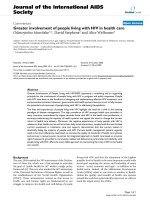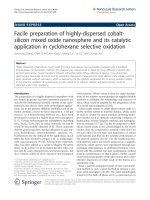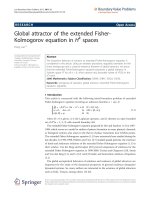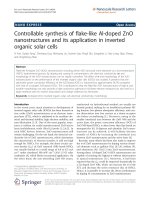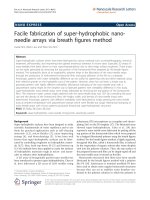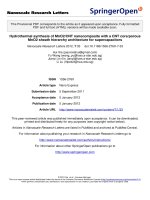Báo cáo hóa học: " Facile Synthesis of ZnO Nanorods by Microwave Irradiation of Zinc–Hydrazine Hydrate Complex Denthaje Krishna Bhat" pot
Bạn đang xem bản rút gọn của tài liệu. Xem và tải ngay bản đầy đủ của tài liệu tại đây (409.62 KB, 5 trang )
NANO EXPRESS
Facile Synthesis of ZnO Nanorods by Microwave Irradiation
of Zinc–Hydrazine Hydrate Complex
Denthaje Krishna Bhat
Received: 2 July 2007 / Accepted: 28 November 2007 /Published online: 11 December 2007
Ó to the authors 2007
Abstract ZnO nanorods have been successfully synthe-
sized by a simple microwave-assisted solution phase
approach. Hydrazine hydrate has been used as a mineral-
izer instead of sodium hydroxide. XRD and FESEM have
been used to characterize the product. The FESEM images
show that the diameter of the nanorods fall in the range of
about 25–75 nm and length in the range of 500–1,500 nm
with an aspect ratio of about 20–50. UV–VIS and photo-
luminescence spectra of the nanorods in solution have been
taken to study their optical properties. A mechanism for
microwave synthesis of the ZnO nanorods using hydrazine
hydrate precursor has also been proposed.
Keywords ZnO Á Nanorods Á Microwave irradiation Á
Optical properties Á Hydrazine hydrate
Introduction
Quasi one—dimensional nanostructured materials (nano-
tubes, nanobelts, nanorods and nanowires) have recently
attracted considerable attention due to their novel proper-
ties and potential applications in numerous areas such as
nanoscale electronics and photonics [1–3]. ZnO is an
important electronic and photonic material because of its
wide band gap of 3.37 eV and high mechanical and ther-
mal stabilities at room temperature [4]. The strong exciton
binding energy of ZnO is much larger than that of GaN and
the thermal energy of ZnO which can ensure an efficient
exciton emission at room temperature [5, 6]. Room tem-
perature UV lasing properties have been demonstrated
from ZnO epitaxial films, nanoclusters and nanowires [2,
7–9]. Hence ZnO is a promising photonic material in the
blue UV region. For example, as UV laser, it can allow
reading compact disks with much more information and
greatly increasing the amount of data stored [10]. In
addition, the low cost, high chemical stability and low
threshold intensity make ZnO an ideal candidate for UV
laser.
The synthesis of one-dimensional single crystalline ZnO
nanostructures has been of increasing interest due to their
promising applications in nanoscale optoelectronic devices
[1, 11–13]. The traditional approaches to synthesize one-
dimensional ZnO nanostructures are the vapour phase
transport processes with the assistance of metal catalysts,
thermal evaporation and template-assisted growth [14–17].
But these processes may introduce impurities in the final
product. Hence, it is conceived that preparation of one-
dimensional ZnO nanostructures via chemical routes
without involving catalysts or templates provides promis-
ing option for the large-scale production of well dispersed
materials [18, 19]. Though single crystalline ZnO nanorods
have been prepared by a modified microemulsion method
[12], the diameters obtained were in the range of 150 nm
only. Generally the preparation methods mentioned above
involve complex procedures, sophisticated equipment and
rigorous experimental conditions. Thus, the development
of low cost and mild synthetic routes to ZnO nanorods or
nanowires is of great significance.
Herein, a novel and facile method for the preparation of
ZnO nanorods by microwave irradiation technique is pre-
sented. The method employs a novel hydrazine hydrate
complex precursor route and mild conditions.
D. K. Bhat (&)
Department of Chemistry, National Institute of Technology
Karnataka, Surathkal, Mangalore 575025, India
e-mail:
123
Nanoscale Res Lett (2008) 3:31–35
DOI 10.1007/s11671-007-9110-4
Experimental
Zinc acetate and hydrazine hydrate were mixed in a molar
ratio of 1:4 in water under stirring. Hydrazine readily
reacted with zinc acetate to form a slurry-like precipitate of
the hybrid complex between them. The stirring of the
slurry was continued for 15 min and then the mixture was
subjected to microwave irradiation at 150 W microwave
power for 10 min. The slurry became clear with a white
precipitate at the bottom. The precipitate was filtered off,
washed with absolute ethanol and distilled water several
times and then dried in vacuum at 60 °C for 4 h.
X-ray diffraction patterns were taken on a Japan Rigaku
D/max rA X-ray Diffractometer equipped with graphite
monochromatized high intensity Cu Ka radiation
(k = 1.54178 A
˚
). The accelerating voltage was set at 0.06°/s
in the 2h range 10–80°. The field emission scanning electron
microscopy (FE-SEM) images and energy dispersive X-ray
analysis (EDXA) were carried out on a FEI Company
FE-SEM. Electron diffraction (ED) patterns and the trans-
mission electron microscope (TEM) images of the nanorods
were recorded on a JEOL (JEM 3010) transmission electron
microscope operating with an accelerating voltage of
300 kV. UV–VIS and photoluminescence spectra of the
ZnO nanorods were measured at room temperature under
carbon tetrachloride dispersion on a Perkin Elmer UV–VIS
and Photoluminescence spectrometers.
Results and Discussion
X-ray Diffraction Pattern (XRD) of ZnO Nanorods
The powder XRD pattern of the as obtained ZnO nanorods
is shown in Fig. 1. All the peaks of the nanorods can be
indexed to the wurtzite single phase ZnO with high crys-
tallinity (JCPDS Card No. 36-1451, a = 3.249 A
˚
,
c = 5.206 A
˚
, space group:P63mc, No.186). No character-
istic peaks of other impurities such as Zn(OH)
2
were
detected in the diffractogram. The higher intensity of (002)
peak compared to bulk ZnO indicated the growth orienta-
tion of ZnO nanorods towards C-axis [20]. The diameter of
the nanorods calculated using Scherrer formula ranges
between 25 nm and 75 nm, which also corresponds to their
diameters observed by FESEM. The XRD pattern of the
zinc acetate–hydrazine hydrate complex precursor is
shown in Fig. 2. The peaks could not be indexed to any
known single compound indicating that this may be a
complex mixture of oxides and hydroxides or an adduct.
Further, the SEM image of the precursor (Fig. 3) also does
not show any interesting morphological features compared
to that of the product i.e., ZnO (Fig. 4). These features
clearly indicate the differences between the precursor and
the product and also the important role played by the
microwave irradiation which converts this precursor to
well-defined nanorods.
FESEM, EDXA, TEM and ED of the Nanorods
The FESEM image of the nanorods is shown in Fig. 5. The
FESEM image reveals that the diameters of the ZnO
nanorods are in the range 25–75 nm, and length in the
range of 500 nm-1.5 lm. The EDXA analysis presented
in Fig. 6 shows that the as-prepared ZnO nanorods contain
Fig. 1 XRD of ZnO nanorods
Fig. 2 XRD of precursor
complex
32 Nanoscale Res Lett (2008) 3:31–35
123
Zn and O only (the Al peak in the spectrum is due to the
background from the FESEM Al grid) and in the atomic
ratio of 1:0.7, indicating the presence of oxygen deficiency,
which might have been caused during the rapid formation
of ZnO nanorods under microwave irradiation. Figure 7
shows the TEM image of the representative nanorods
which further supports the results obtained by the FESEM
images. The ED pattern of the nanorods is shown in Fig. 8
suggests the single crystalline nature of the nanorods and
can be indexed to the wurtzite single phase ZnO. The
preferential growth direction of these rods was along the c
axis of the crystal lattice.
UV–VIS and Photoluminescence Spectra of ZnO
Nanorods
The room temperature UV–VIS absorption spectrum of
the ZnO nanorods is shown in Fig. 9. The spectrum
shows a typical exitation absorption band at 372 nm that
is blue shifted with respect to the bulk absorption edge
which appears at 400 nm, this shift may be ascribed to
the nanometric size effect of the synthesized ZnO [4].
The photoluminescence spectra of the ZnO nanorods
have been measured with an excitation wavelength of
325 (curve a) and 350 nm (curve b) and are shown in
Fig. 10. The photoluminescence spectrum at both the
wavelengths exhibited similar features. However, the
intensity of the luminescence at higher excitation wave-
length was higher than the lower one. The following
emission bands have been observed: A UV emission
band at 385 nm, a violet band at 407 nm, a strong blue
band at 459 nm, a blue green band at 485 nm and a
green band at 529 nm. The UV emission band is due to
the recombination of excitonic centres in the nanorod and
also as a result of quantum confinement effect [21]. The
green emission corresponds to the singly occupied oxy-
gen vacancy in ZnO and results from the recombination
of a photo-generated hole with the single ionized charge
state of this defect. The weak green emission also implies
that there are few surface defects in the ZnO nanorods,
which is in agreement with the result obtained from
EDXA observation [22, 23]. Although the blue emission
has been reported in the ZnO nanorods, the mechanism is
not clear [5, 24].
Possible Formation Mechanism
A possible chemical mechanism for the microwave
formation of ZnO nanorods may be expressed as follows:
Fig. 3 SEM of precursor complex
Fig. 4 SEM of ZnO nanorods
Fig. 5 FESEM image of ZnO nanorods
Nanoscale Res Lett (2008) 3:31–35 33
123
mZn CH
3
COOðÞ
2
þ nN
2
H
4
! [Zn(CH
3
COO)
2
]
m
[N
2
H
4
]
n
[Zn CH
3
COOðÞ
2
]
m
[N
2
H
4
]
n
! mZn
2þ
þ nN
2
H
4
þ 2m CH3COOðÞ
2À
3N
2
H
4
þ 4H
2
O ! 4NH
4
OH þ N
2
Zn
2þ
þ 2NH
4
OH ! ZnO#þ2NH
þ
4
þ H
2
O
It is worthwhile to note here that under microwave
irradiation, zinc acetate with only ammonium hydroxide
does not yield any nanomaterial. Hence it may be
concluded that it is the hydrazine complex which does
the magic by acting both as a ligand and as a capping agent
to yield 1D nanomaterial.
Conclusions
A facile route for the synthesis of ZnO nanorod by
microwave irradiation method has been reported. The
method offers a very simple and low cost route for the
production of ZnO nanorods. ZnO nanorods have been
Fig. 7 TEM of ZnO nanorods
Fig. 6 EDXA of ZnO nanorods
Fig. 8 ED of ZnO nanorods
34 Nanoscale Res Lett (2008) 3:31–35
123
characterized by XRD, FESEM and EDXA. A possible
formation mechanism has been proposed via a zinc ace-
tate–hydrazine hydrate complex formation. Hydrazine
hydrate complex acts as ligand and capping agent facili-
tating the formation of ZnO 1D nanomaterial. The method
may also be extended for the preparation of other
nanomaterials.
Acknowledgements Financial support in the form of a young sci-
entist project grant and a SERC visiting fellowship from DST,
Government of India is gratefully acknowledged. The author is also
thankful to Prof. CNR Rao of JNCASR, Bangalore, for laboratory
facilities and encouragement.
References
1. Z.W. Pan, Z.R. Dai, Z.L. Wang, Science 291, 1947 (2001)
2. M.H. Huang, S. Mao, H. Feick, H. Yan, Y. Wu, H. Kind, E.
Weber, R. Russo, P. Yang, Science 292, 1897 (2001)
3. C.M. Leiber, Solid State Commun. 107, 607 (1998)
4. S.C. Lyu, Y. Zhang, H. Ruh, H J. Lee, H W. Shim, E K. Suh,
C.J. Lee, Chem. Phys. Lett. 363, 164 (2002)
5. J J. Wu, S.C. Liu, Adv. Mater. 14, 215 (2002)
6. W. Park, G C. Yi, M. Kim, S.J. Pennycook, Adv. Mater. 14,
1841 (2002)
7. Z.K. Tang, G.K.L. Wong, P. Yu, M. Kawasaki, A. Ohtomo, H.
Koinuma, Y. Segawa, Appl. Phys. Lett. 72, 3270 (1998)
8. H. Co, J.Y. Xu, E.W. Seeling, R.P.H. Chang, Appl. Phys. Lett.
76, 2997 (2000)
9. K. Govender, D.S. Boyle, P. O’Brien, D. Binks, D. West, D.
Coleman, Adv. Mater. 14, 1221 (2002)
10. Y.C. Kong, D.P. Yu, B. Zhang, W. Fang, S.Q. Feng, Appl. Phys.
Lett. 78, 407 (2001)
11. J. Zhang, L.D. Sun, C.S. Liao, C.H. Yan, Chem.Commun. 262
(2002)
12. L. Guo, Y.L. Ji, H.B. Xu, P. Simon, Z.Y. Wu, J. Am. Chem. Soc.
124, 14864 (2002)
13. B. Liu, H.C. Zheng, J. Am. Chem. Soc. 125, 4430 (2003)
14. Y. Li, G.W. Meng, L.D. Zhang, F. Phillipp, Appl. Phys. Lett. 76,
2011 (2000)
15. S.Y. Li, C.Y. Lee, T.Y. Tseng, J. Cryst. Growth. 247, 357 (2003)
16. L. Vayssieres, K. Keis, S.E. Lindquist, A. Hagfedt, J. Phys.Chem.
B. 105, 3350 (2001)
17. J.Q. Hu, Q. Li, N.B. Wong, C.S. Lee, S.T. Lee, Chem. Mater. 14,
1216 (2002)
18. X. Wang, Y.D. Li, J. Am. Chem. Soc. 41, 2446 (2002)
19. T. Kasuga, M. Hiramatsu, A. Hoson, T. Sekino, K. Nihara, Adv.
Mater. 11, 1307 (1999)
20. V. Pachauri, C. Subramaniyam, T. Pradeep, Chem. Phys. Lett.
423, 240 (2006)
21. M.H. Hong, Y.Y. Wu, H.N. Feick, N. Tran, E. Weber, P.D. Yang,
Adv. Mater. 13, 113 (2001)
22. K. Vanheusden, W.L. Wrren, C.H. Seager, D.R. Tallant, J.A.
Voigt, B.E. Gnade, J. Appl. Phys. 79, 7983 (1996)
23. S. Monticone, R. Tufeu, A.V. Kanev, J. Phys. Chem. B. 102,
2854 (1998)
24. Z. Fu, B. Lin, G. Liao, Z. Wu, J. Cryst. Growth. 193, 316 (1998)
Fig. 10 Photoluminescence spectra of ZnO nanorods
Fig. 9 UV–VIS spectra of ZnO nanorods
Nanoscale Res Lett (2008) 3:31–35 35
123


